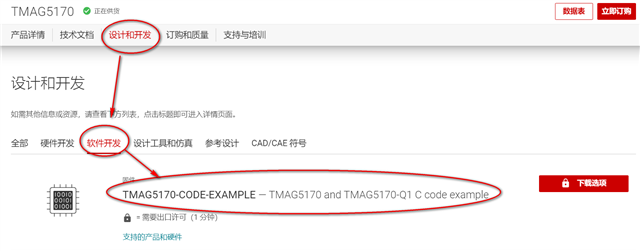使用stm32f103,的spi2外设与TMAG5170,无法通信,如果这些初始化函数没有问题下一步应该怎么配置,有没有配置步骤,万分感谢
void SPI2_Initt_mag5170(void)
{
GPIO_InitTypeDef GPIO_InitStructure;
SPI_InitTypeDef SPI_InitStructure;
/* Enable SPI2 and GPIOB clock */
RCC_APB2PeriphClockCmd( RCC_APB2Periph_GPIOB, ENABLE );
RCC_APB2PeriphClockCmd( RCC_APB2Periph_GPIOC, ENABLE );
RCC_APB1PeriphClockCmd( RCC_APB1Periph_SPI2, ENABLE );
/* Configure PB12 as L_CS -------------------------*/
GPIO_InitStructure.GPIO_Pin = GPIO_Pin_12 ;
GPIO_InitStructure.GPIO_Speed = GPIO_Speed_50MHz;
GPIO_InitStructure.GPIO_Mode = GPIO_Mode_Out_PP;
GPIO_Init(GPIOB, &GPIO_InitStructure);
/* Configure PD8 as R_CS -------------------------*/
GPIO_InitStructure.GPIO_Pin = GPIO_Pin_6 ;
GPIO_InitStructure.GPIO_Speed = GPIO_Speed_50MHz;
GPIO_InitStructure.GPIO_Mode = GPIO_Mode_Out_PP;
GPIO_Init(GPIOC, &GPIO_InitStructure);
GPIO_InitStructure.GPIO_Pin =GPIO_Pin_13 | GPIO_Pin_14 | GPIO_Pin_15;
GPIO_InitStructure.GPIO_Mode = GPIO_Mode_AF_PP;
GPIO_InitStructure.GPIO_Speed = GPIO_Speed_50MHz;
GPIO_Init(GPIOB, &GPIO_InitStructure);
GPIO_SetBits(GPIOB,GPIO_Pin_13|GPIO_Pin_14|GPIO_Pin_15);
SPI_InitStructure.SPI_Direction = SPI_Direction_2Lines_FullDuplex;
SPI_InitStructure.SPI_Mode = SPI_Mode_Master;
SPI_InitStructure.SPI_DataSize = SPI_DataSize_8b;
SPI_InitStructure.SPI_CPOL = SPI_CPOL_Low ;
SPI_InitStructure.SPI_CPHA = SPI_CPHA_1Edge;
SPI_InitStructure.SPI_NSS = SPI_NSS_Soft;
SPI_InitStructure.SPI_BaudRatePrescaler = SPI_BaudRatePrescaler_256 ;
SPI_InitStructure.SPI_FirstBit = SPI_FirstBit_MSB;
SPI_InitStructure.SPI_CRCPolynomial = 7;
/* SPI2 configuration */
SPI_Init(SPI2, &SPI_InitStructure);
/* Enable SPI2 */
SPI_Cmd(SPI2, ENABLE);
//SPI2_ReadWriteByte(0xff);
MLX_CS_HIGH(Right);
MLX_CS_HIGH(Left);
Delay_ms(100);
}
//¶Á¼Ä´æÆ÷
uint16_t normalReadRegister( uint8_t address,unsigned char Location)
{
uint8_t dataTx[4] = { 0 };
uint8_t dataRx[4] = { 0 };
unsigned short output[2] = { 0 };
uint8_t cmd_bits ;
dataTx[0] = (address | 0x80);
dataTx[1] = 0x00;
dataTx[2] = 0x00;
dataTx[3] = cmd_bits << 4;
int i;
int byteLength = 4;
MLX_CS_LOW(Location);
for (i = 0; i < byteLength; i++)
{
dataRx[i] = SPI2_ReadWriteByte(dataTx[i]);
}
output[0] = (dataRx[1] << 8) | dataRx[2];
output[1] = (dataRx[0] << 4) | (dataRx[3] >> 4);
MLX_CS_HIGH(Location);
return output[0];
}
//д¼Ä´æÆ÷
void writeToRegister(uint8_t address, uint16_t data_to_write,unsigned char Location)
{
// Check that the input address is in range
unsigned short output[2] = { 0 };
// Build TX and RX byte arrays
uint8_t dataTx[4] = { 0 };
uint8_t dataRx[4] = { 0 };
// MSB is 0 for WRITE command
dataTx[0] = (address);
dataTx[1] = (data_to_write >> 8);
dataTx[2] = (data_to_write);
dataTx[3] = 0x00;
int i;
int byteLength = 4;
MLX_CS_LOW(Location);
for (i = 0; i < byteLength; i++)
{
dataRx[i] = SPI2_ReadWriteByte(dataTx[i]);
}
output[0] = (dataRx[1] << 8) | dataRx[2];
output[1] = (dataRx[0] << 4) | (dataRx[3] >> 4);
MLX_CS_HIGH(Location);
}

